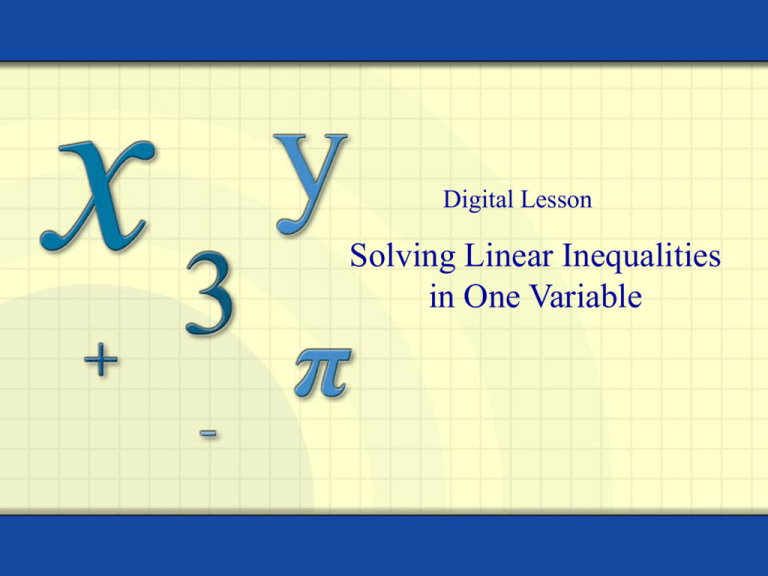
Digital Lesson
Solving Linear Inequalities
in One Variable
A linear inequality in one variable is an inequality
which can be put into the form
ax + b > c
where a, b, and c are real numbers.
Note that the “>” can be replaced by , <, or .
Examples: Linear inequalities in one variable.
2x + 3 > 4
2x – 2 < 6x – 5 can be written –4x + (–2) < –5.
6x + 1 3(x – 5) can be written 6x + 1 –15.
Copyright © by Houghton Mifflin Company, Inc. All rights reserved.
2
The solution set for an inequality can be expressed in two ways.
Example: Express the solution set of x < 3 in two ways.
Rounded parentheses indicate
that the number is not included
in the solution set.
1. Set-builder notation: {x | x < 3}
2. Graph on the real line:
)
-4 -3 -2 -1
0
1
2
3
4
Example: Express the solution set of x 4 in two ways.
1. Set-builder notation: {x | x 4}
2. Graph on the real line:
Copyright © by Houghton Mifflin Company, Inc. All rights reserved.
Square brackets indicate
that the number is included
in the solution set.
]
-4 -3 -2 -1
0
1
2
3
4
3
A solution of an inequality in one variable is a number
which, when substituted for the variable, results in a true
inequality.
Examples: Are any of the values of x given below
solutions of 2x > 5?
?
?
x=2
2(2) > 5
4 > 5 False 2 is not a solution.
?
?
x = 2.6 2(2.6) > 5 5.2 > 5 True 2.6 is a solution.
?
?
x=3
2(3) > 5
6 > 5 True 3 is a solution.
?
?
x = 1.5 2(1.5) > 5
3 > 5 False 1.5 is not a solution.
The solution set of an inequality is the set of all solutions.
Copyright © by Houghton Mifflin Company, Inc. All rights reserved.
4
Addition and Subtraction Properties
• If a > b and c is a real number, then
a > b, a + c > b + c, and a – c > b – c have the same solution set.
• If a < b and c is a real number, then
a < b, a + c < b + c, and a – c < b – c have the same solution set.
Example: Solve x – 4 > 7.
x–4+4>7+4
x > 11
{x | x > 11}
Add 4 to each side of the inequality.
Set-builder notation.
Example: Solve 3x 2x + 5.
3x – 2x 2x + 5 – 2x Subtract 2x from each side.
x5
Set-builder notation.
{x | x 5}
Copyright © by Houghton Mifflin Company, Inc. All rights reserved.
5
Multiplication and Division Properties
• If c > 0 the inequalities a > b, ac > bc, and
same solution set.
• If c < 0 the inequalities a > b, ac < bc, and
same solution set.
Example: Solve 4x 12.
4x 12
( 4) ( 4)
x3
1
Example: Solve x 4 .
3
1
x (– 3) 4 (–3)
3
x 12
Copyright © by Houghton Mifflin Company, Inc. All rights reserved.
a
>
c
a
<
c
b
have the
c
b
have the
c
Divide by 4.
4 is greater than 0, so the
inequality sign remains the same.
Multiply by – 3.
– 3 is less than 0, so the inequality sign
changes.
6
Example: Solve x + 5 < 9x + 1.
– 8x + 5 < 1
– 8x < – 4
1
2
1
x
|
x
2
x>
Example: Solve 4 x 2 3 x 4.
5
5
1
x2 4
5
1
x6
5
x 30
[
Subtract 9x from both sides.
Subtract 5 from both sides.
Divide both sides by – 8 and simplify.
Inequality sign changes because of
division by a negative number.
Solution set in set-builder notation.
Subtract
3
x from both sides.
5
Add 2 to both sides.
Multiply both sides by 5.
Solution set as a graph.
-20 -10 0 10 20 30 40 50 60
Copyright © by Houghton Mifflin Company, Inc. All rights reserved.
7
A compound inequality is formed by joining two inequalities
with “and” or “or.”
Example: Solve x + 2 < 5 and 2x – 6 > – 8.
Solve the first inequality.
Solve the second inequality.
x+2<5
2x – 6 > – 8
x < 3 Subtract 2.
2x > – 2 Add 6.
{x | x < 3} Solution set
x > – 1 Divide by 2.
{x | x > –1} Solution set
The solution set of the “and” compound inequality is the
intersection of the two solution sets.
x | x 3 x | x 1 x | 1 x 3
(
-4 -3 -2 -1
Copyright © by Houghton Mifflin Company, Inc. All rights reserved.
)
0
1
2
3
4
8
When solving compound inequalities, it is possible to work
with both inequalities at once.
This inequality means
Example: Solve 11 < 6x + 5 < 29. 11 < 6x + 5 and 6x + 5 < 29.
6 < 6x < 24 Subtract 5 from each of the three parts.
1 < x < 4 Divide 6 into each of the three parts.
x | 1 x 4 Solution set.
1
Example: Solve 8 x 6 5.
2
1
2 x 1 Subtract 6 from each part.
2
Multiply each part by – 2.
Multiplication by a negative number
4 x 2
[
-4 -3 -2 -1
changes the inequality sign for each part.
Solution set.
]
0
1
2
3
4
Copyright © by Houghton Mifflin Company, Inc. All rights reserved.
9
Example: Solve x + 5 > 6 or 2x < – 4.
Solve the first inequality.
Solve the second inequality.
2x < – 4
x < –2
{ x | x < – 2} Solution set
x+5>6
x>1
{ x | x > 1} Solution set
Since the inequalities are joined by “or” the solution set is the
union of the solution sets.
x | x 1 x | x 2
)
-4 -3 -2 -1
Copyright © by Houghton Mifflin Company, Inc. All rights reserved.
(
0
1
2
3
4
10
Example: A cell phone company offers its customers a rate of
$89 per month for 350 minutes, or a rate of $40 per month
plus $0.50 for each minute used.
How many minutes per month can a customer who chooses the
second plan use before the charges exceed those of the first plan?
Let x = the number of minutes used.
Solve the inequality 0.50x + 40 89 .
0.50x 49
Subtract 40.
x 24.5 Divide by 0.5.
The customer can use up to 24.5 minutes per month before the
cost of the second plan exceeds the cost of the first plan.
Copyright © by Houghton Mifflin Company, Inc. All rights reserved.
11








